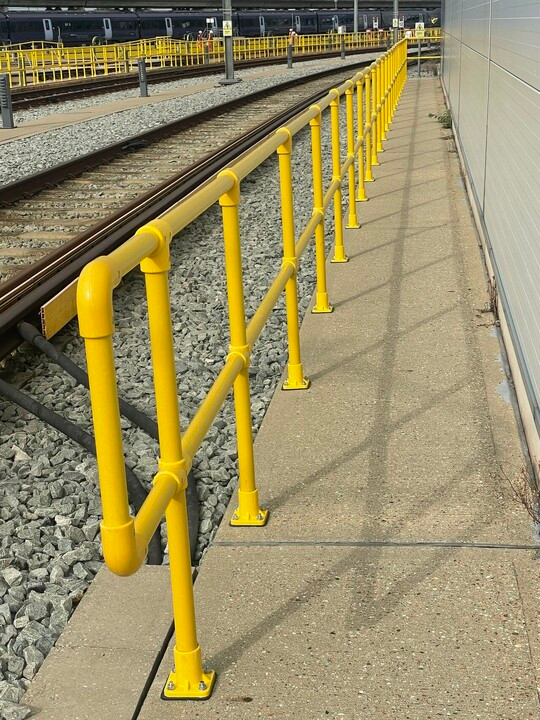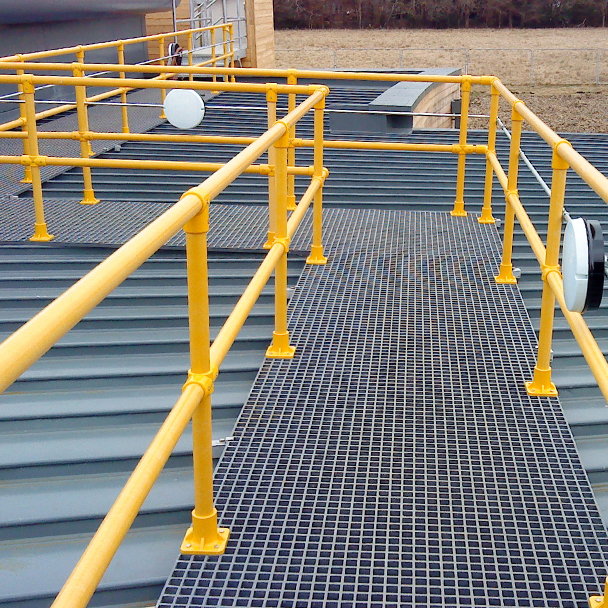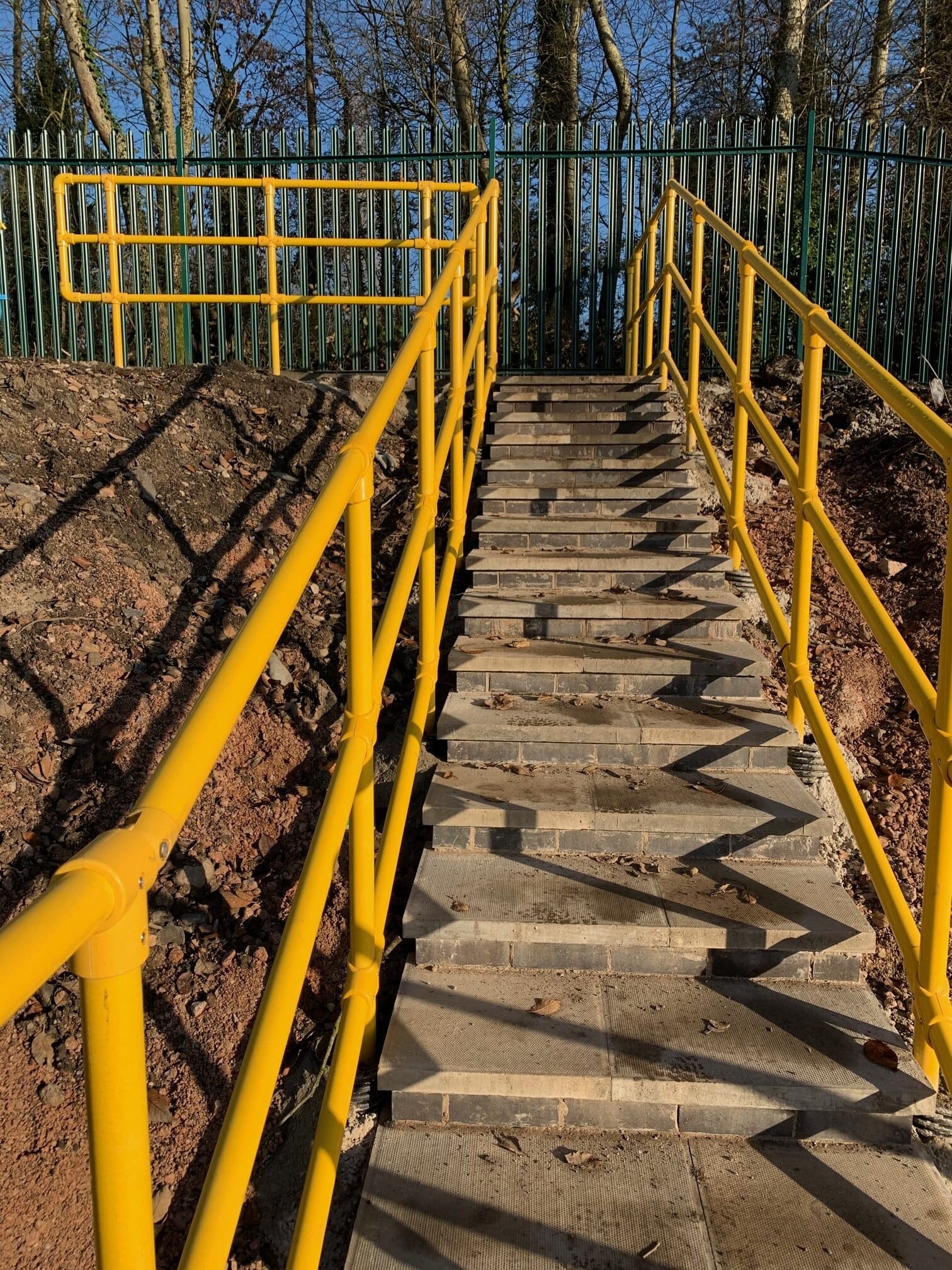FRP (Fiber-Reinforced Plastic) Platform is a high-strength, lightweight, and corrosion-resistant structural component widely used in industrial, commercial, and marine applications. It serves as a durable and low-maintenance alternative to traditional materials like steel, aluminum, and wood.
제품 성능 소개
This article provides an in-depth overview of FRP Platforms, including their physical properties, specifications, advantages, disadvantages, and applications.
1. Physical Properties of FRP Platform
1.1. Strength and Load Capacity
-
높은 강도 대 중량비 – Stronger than wood and aluminum, with comparable strength to steel.
-
Excellent Load-Bearing Capacity – Can support heavy equipment, personnel, and industrial machinery.
-
Impact and Shock Resistance – Can withstand mechanical impact and vibrations without permanent deformation.
1.2. Corrosion and Environmental Resistance
-
Resistant to Corrosion and Rust – Ideal for marine, chemical, and wastewater treatment plants.
-
Non-Degradable in Moisture and Humid Environments – Performs well in wet and high-humidity conditions.
-
UV-Resistant Coating Available – Protects against sunlight degradation for outdoor use.
1.3. Electrical and Thermal Properties
-
비전도성 – Provides electrical insulation, making it safe for power plants and electrical substations.
-
Low Thermal Conductivity – Reduces heat transfer, useful in high-temperature or extreme weather environments.
1.4. Fire Resistance
-
Fire-Retardant Options Available – Can be made with phenolic or fire-resistant resins.
-
Low Smoke and Toxicity Emissions – Safer for confined spaces and high-occupancy areas.
2. Specifications and Design Options
2.1. Standard Dimensions and Load Ratings
FRP Platforms are available in various sizes and configurations based on load requirements and application needs:
-
두께: 25mm (1") to 50mm (2")
-
Panel Sizes: 1m × 1m, 1.2m × 2.4m, or custom sizes
-
Load Capacities: Up to 5,000 kg/m² depending on design and support spacing
2.2. Types of FRP Platforms
-
FRP Grating Platforms – Open-mesh platforms for drainage and slip resistance.
-
Solid FRP Platforms – Continuous surface for cleanrooms, chemical plants, and food industries.
-
Modular FRP Platforms – Customizable pre-engineered platforms with easy installation.
2.3. Material Composition
FRP Platforms consist of:
-
Reinforcement Fibers:
-
E-glass – Standard high-strength fiber.
-
S-glass or Carbon Fiber – Higher-performance options for specialized applications.
-
-
Resins for Various Applications:
-
Polyester Resin – Cost-effective, general-purpose use.
-
비닐 에스테르 수지 – Better chemical resistance.
-
에폭시 수지 – Higher strength and durability.
-
페놀수지 – Best fire resistance.
-
2.4. Mechanical Properties (Typical Values)
| 재산 | Typical Value |
|---|---|
| 인장강도 | 250-600 MPa |
| 굽힘 강도 | 200-500 MPa |
| 압축 강도 | 250-550 MPa |
| 밀도 | 1.5-2.0 g/cm³ |
| Modulus of Elasticity | 20-35 GPa |
3. Advantages of FRP Platforms
3.1. Lightweight and Easy to Handle
-
Up to 70% lighter than steel, making it easier to transport and install.
-
Reduces structural load in multi-story buildings and large-scale installations.
3.2. Corrosion and Chemical Resistance
-
Does not rust, corrode, or degrade, even in marine, wastewater, and chemical environments.
-
Ideal for exposure to acids, alkalis, and solvents.
3.3. Electrical and Magnetic Safety
-
Non-Conductive Material – Prevents electrical hazards.
-
Non-Magnetic – Suitable for sensitive electronic environments.
3.4. Slip-Resistant and Safe
-
Available with anti-slip coatings 또는 integrated grit surfaces.
-
Reduces the risk of accidents in industrial, wet, or hazardous work areas.
3.5. Low Maintenance and Long Lifespan
-
No painting, sealing, or chemical treatments required.
-
Does not warp, crack, or degrade over time.
3.6. Customizable and Versatile
-
Can be cut, drilled, and shaped easily.
-
Available in different colors and finishes for aesthetic or safety purposes.
4. Disadvantages of FRP Platforms
4.1. Higher Initial Cost
-
More expensive than steel or aluminum upfront.
-
However, lower maintenance and longer lifespan offset initial costs.
4.2. Lower Stiffness Compared to Steel
-
More flexible than steel, requiring additional supports for heavy loads.
-
Not recommended for highly load-sensitive applications without proper reinforcement.
4.3. UV Degradation (If Unprotected)
-
Prolonged exposure to direct sunlight can cause minor surface wear.
-
Requires UV-resistant coatings for outdoor use.
4.4. Limited High-Temperature Resistance
-
FRP starts to degrade above 150-200°C, unlike steel, which withstands extreme heat.
-
Fire-resistant versions are available but come at higher costs.
4.5. Recycling Challenges
-
Difficult to recycle due to the composite nature of the material.
-
Limited disposal or reuse options compared to metals.
5. Applications of FRP Platforms
5.1. Industrial and Infrastructure Uses
-
Oil and Gas Refineries – Resistant to chemicals, extreme temperatures, and corrosion.
-
Chemical Processing Plants – Ideal for corrosive and high-moisture environments.
-
Wastewater Treatment Facilities – Does not degrade in sewage, water, or chemical exposure.
5.2. Marine and Offshore Applications
-
Dock, Pier, and Ship Deck Platforms – High saltwater resistance.
-
Offshore Rigs and Floating Structures – Lightweight yet strong enough for harsh environments.
5.3. Construction and Public Infrastructure
-
Bridges, Walkways, and Stairs – Provides durability with minimal maintenance.
-
Public Facilities and Transit Stations – Non-slip safety platforms for pedestrians.
5.4. Electrical and Telecommunications
-
Substations and High-Voltage Areas – Non-conductive and electrically safe.
-
Communication Towers and Antenna Installations – Lightweight, corrosion-resistant solutions.
5.5. Food and Pharmaceutical Industries
-
Sanitary and Chemical-Resistant – Used in cleanrooms, food processing, and medical labs.
-
Non-Toxic and Hygienic Surface – Prevents bacterial growth.
6. Conclusion
FRP Platforms provide a strong, corrosion-resistant, and low-maintenance alternative to metal and wood platforms. They offer superior durability, non-conductivity, and chemical resistance, making them ideal for industrial, marine, and electrical applications.
FRP Platform
시리즈 :
주요제품 >애플리케이션
Industrial Plants and Chemical Factories Offshore Platforms and Marine Environments Water and Wastewater Treatment Facilities Power Plants and Substations Public Transport Stations and Pedestrian Bridges Construction Sites and Warehouses
상표명 :
TF컴포지트
상품명 :
GRP Handrail
재료 :
유리 섬유
색상 :
Yellow,Other
자주하는 질문
질문 :
How Strong are GRP Handrails Compared to Steel?
ㅏ :
GRP Handrails offer excellent strength-to-weight ratio, often comparable to steel. While steel may have higher load-bearing capacity, GRP provides sufficient strength for most industrial and commercial applications, particularly in corrosive environments.
질문 :
Are GRP Handrails Suitable for Marine and Offshore Applications?
ㅏ :
Yes, GRP Handrails are ideal for marine environments. They are resistant to saltwater corrosion and UV exposure, making them a preferred choice for docks, ships, and offshore platforms.
질문 :
How Are GRP Handrails Installed?
ㅏ :
GRP Handrails are designed for easy installation using a modular system. Components are typically bolted together without the need for welding. Standard tools are sufficient, reducing installation time and labor costs.
질문 :
Can GRP Handrails Be Customized?
ㅏ :
Absolutely! GRP Handrails can be customized in terms of: Dimensions (tube size, post height, spacing) Colors (often yellow for high visibility) Finishes (smooth, textured, or anti-slip) Configurations (single or multi-rail systems)
질문 :
Do GRP Handrails Require Maintenance?
ㅏ :
No, GRP Handrails require minimal maintenance. Unlike metal, they do not rust or corrode. Periodic cleaning with water and mild detergent is generally sufficient.
질문 :
Are GRP Handrails Electrically Conductive?
ㅏ :
No, GRP Handrails are non-conductive, making them ideal for environments with electrical hazards like power plants and substations.
질문 :
Are GRP Handrails Fire Resistant?
ㅏ :
GRP Handrails can be manufactured with fire-retardant resins to meet fire safety standards. Always check with the manufacturer for the appropriate fire rating for your application.
질문 :
What is the Typical Lifespan of a GRP Handrail?
ㅏ :
GRP Handrails typically last over 20 years, even in harsh environments. Their resistance to corrosion, UV damage, and weathering contributes to their long service life.
기타 관련 제품














